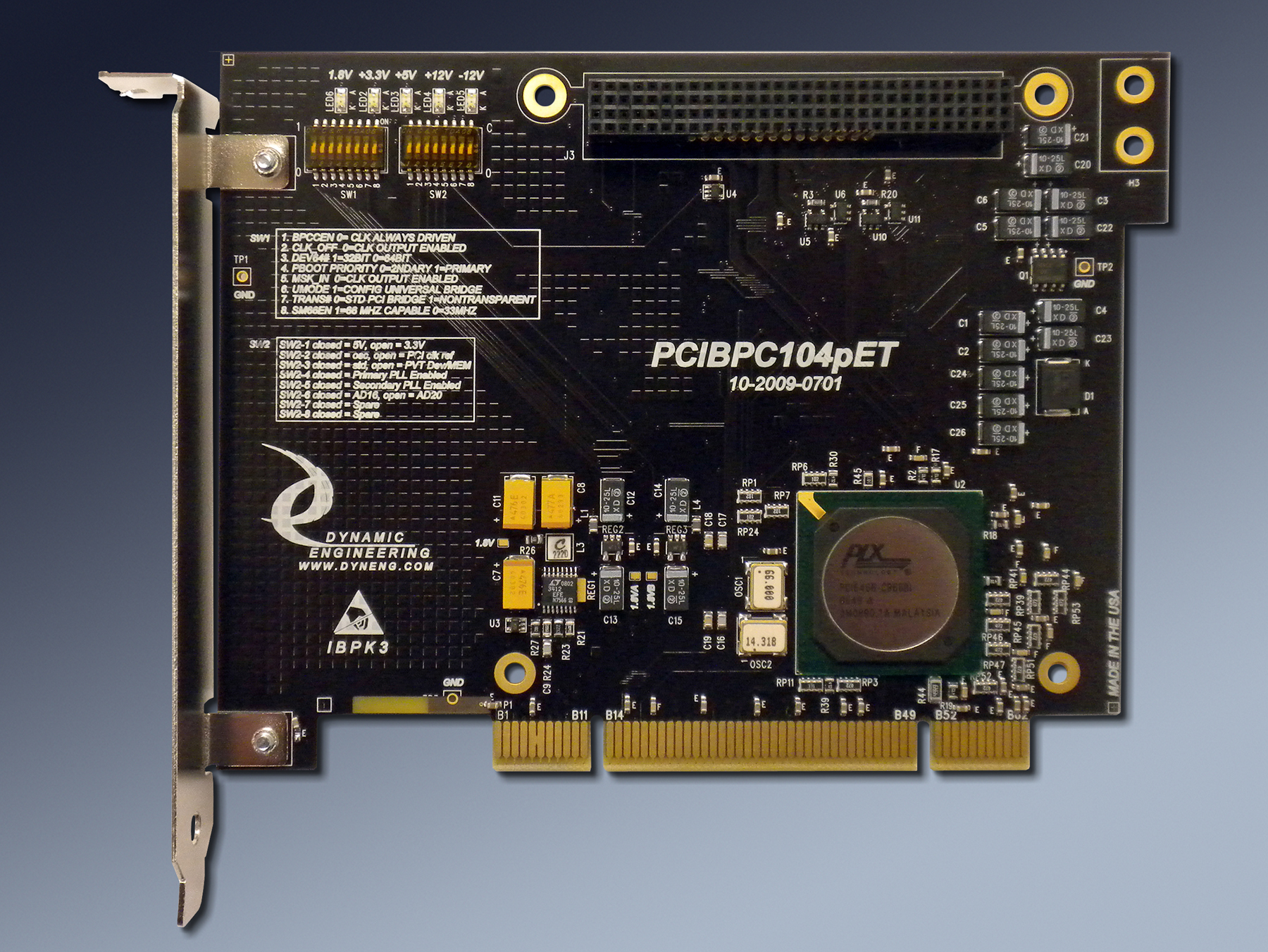PCIBPC104pET
PCI to PC104p/PCI-104 Adapter/Carrier - Bridge Base for Multiple Modules
PCIBPC104pET Description
- PC104p - PCI-104 compatible carrier
- Universal voltage PCI interface with 32-bit data path and 33/66 clock rate
- Up to 4 active modules can be mounted
- Front and/or Rear mounting for modules
- PC104p Module IO ports open for front or rear IO applications
- 1 year warranty standard. Extended warranty available.
- Extended [Industrial] Temperature standard.
- ROHS and Standard processing available
This design is from 2009 and features an EOL bridge. Dynamic Engineering is planning PCIeBPC104p to support stacked PC104p modules going forward. The passive model PCI2PC104p is available to order and features options for test and production support. Should you need the bridged PCI version please contact Dynamic Engineering. With an update the PCI version can be resurrected. At this time, the data sheet is provided for reference purposes.
Save money with the PCIBPC104pET. If you need to get your product to market fast, think about reusing existing PC104p and PCI-104 designs in PCI applications. For small production runs it will be less expensive without paying for a new design and layout. For new PC104p and PCI-104 designs PCIBPC104pET can decrease your time to market by allowing your engineers to debug in a PC. A PC will provide better tools and visablility into the hardware.
Contact Dyanamic Engineering about converting your PC104p design to PCI and vice-versa.
PCIBPC104pET adapter/carrier converter card provides the ability to install 1-4 active PC104p or PCI-104 cards into a standard PCI slot. PCIBPC104pET has a PC104p and PCI-104 compatible stack position mounted to a universal voltage shorter than 1/2 length PCI card. The PC104p position is stackable with all 4 active positions usable. Additional non-PCI cards can also be added. PCI power is routed to the PC104p stack with heavy planes allowing enough current to cover the PC104p specification. Interrupts are routed to the PCI connector. Request and Grant lines are handled by the bridge locally and back to the host on the PCI bus to allow for bus master operation. The design is robust with extended temperature components, impedance controlled, PCI compliant routing, heavy power planes with decoupling for the PC104p voltages, and more. With the PCIBPC104pET (PCI Bridge PC104p/PCI-104 Extended Temperature) all you have to do is install your PC104p onto the adapter, and plug into the PCI slot. PCIBPC104pET is compatible with 32 bit PCI slots. The PC104p positions can be programmed to use 3.3 or 5V for VIO. The bridge provides plug and play operation.
The PCI bus is interconnected to the PC104p module via a 64 bit 66 MHz capable bridge. The bridge allows the PCI bus to operate with different parameters than the PC104p stack - for example the PCI bus can operate at 66 MHz with 32 bit data and the PMC with 33 MHz and 32 bit data. Please note the PCI connector is 32 bit with the upper portion of the bus tied off. The buffering within the bridge will take care of the rate and data matching. The local side can also operate at 66 if the PC104p stack supports it. PCIBPC104pET can control the M66EN signal via a dipswitch setting or the PC104p stack can control the M66EN setting directly.
The voltage definitions are also buffered between the PCI and PC104p buses. The PCI VIO automatically defines the reference levels for the primary side of the bridge. A switch is used to control a MOSFET to select which voltage reference is used on the secondary side. A 5V PC104p stack can be used with a 3.3V PCI bus and vice-versa. The voltages can also be the same.
The bridge insures that multiple PCIBPC104pET cards can be installed onto the same PCI bus stub.
The 3.3V Aux. 3.3V, 5V, +12 and -12V voltages are supplied to the PC104p stack via the PCI connector. The voltages are bypassed at the PCI connector and at the PC104p stack connector. Heavy planes are used to supply more than 1A per pin at the PC104p stack. This is more current than allowed by the PCI or PC104p specifications to allow for designs that are a bit over the limit of the power specifications.
The IO area allowed by the PC104p and PCI-104 specifications are left clear to allow for standard cable options based on the module installed.
If you have custom requirements please call or e-mail us with the details. We can make customer specific versions of the PCIBPC104pET.
Save money with the PCIBPC104pET. If you need to get your product to market fast, think about reusing existing PC104p and PCI-104 designs in PCI applications. For small production runs it will be less expensive without paying for a new design and layout. For new PC104p and PCI-104 designs PCIBPC104pET can decrease your time to market by allowing your engineers to debug in a PC. A PC will provide better tools and visablility into the hardware.
Contact Dyanamic Engineering about converting your PC104p design to PCI and vice-versa.
PCIBPC104pET adapter/carrier converter card provides the ability to install 1-4 active PC104p or PCI-104 cards into a standard PCI slot. PCIBPC104pET has a PC104p and PCI-104 compatible stack position mounted to a universal voltage shorter than 1/2 length PCI card. The PC104p position is stackable with all 4 active positions usable. Additional non-PCI cards can also be added. PCI power is routed to the PC104p stack with heavy planes allowing enough current to cover the PC104p specification. Interrupts are routed to the PCI connector. Request and Grant lines are handled by the bridge locally and back to the host on the PCI bus to allow for bus master operation. The design is robust with extended temperature components, impedance controlled, PCI compliant routing, heavy power planes with decoupling for the PC104p voltages, and more. With the PCIBPC104pET (PCI Bridge PC104p/PCI-104 Extended Temperature) all you have to do is install your PC104p onto the adapter, and plug into the PCI slot. PCIBPC104pET is compatible with 32 bit PCI slots. The PC104p positions can be programmed to use 3.3 or 5V for VIO. The bridge provides plug and play operation.
The PCI bus is interconnected to the PC104p module via a 64 bit 66 MHz capable bridge. The bridge allows the PCI bus to operate with different parameters than the PC104p stack - for example the PCI bus can operate at 66 MHz with 32 bit data and the PMC with 33 MHz and 32 bit data. Please note the PCI connector is 32 bit with the upper portion of the bus tied off. The buffering within the bridge will take care of the rate and data matching. The local side can also operate at 66 if the PC104p stack supports it. PCIBPC104pET can control the M66EN signal via a dipswitch setting or the PC104p stack can control the M66EN setting directly.
The voltage definitions are also buffered between the PCI and PC104p buses. The PCI VIO automatically defines the reference levels for the primary side of the bridge. A switch is used to control a MOSFET to select which voltage reference is used on the secondary side. A 5V PC104p stack can be used with a 3.3V PCI bus and vice-versa. The voltages can also be the same.
The bridge insures that multiple PCIBPC104pET cards can be installed onto the same PCI bus stub.
The 3.3V Aux. 3.3V, 5V, +12 and -12V voltages are supplied to the PC104p stack via the PCI connector. The voltages are bypassed at the PCI connector and at the PC104p stack connector. Heavy planes are used to supply more than 1A per pin at the PC104p stack. This is more current than allowed by the PCI or PC104p specifications to allow for designs that are a bit over the limit of the power specifications.
The IO area allowed by the PC104p and PCI-104 specifications are left clear to allow for standard cable options based on the module installed.
If you have custom requirements please call or e-mail us with the details. We can make customer specific versions of the PCIBPC104pET.
PCIBPC104pET Features
Size
Shorter than half-length PCI card.
Slots
1 PC104p/PCI-104 stack position provided with connections to support 4 modules.
Clocks
PCI bus can operate at 66 or 33 MHz. The installed module must be 66 MHz capable for 66 MHz operation to work properly. M66EN can be used automatically or by manual override.
Access Width
Standard PCI byte lanes supported for byte, word, and long-access dependent on installed PC104p or PCI-104 module(s).
Software Interface
Module register definitions as defined by installed hardware. No software set-up required by PCIBPC104pET.
Interrupts
INTA, B, C, D routed to PCI connector from PC104p/PCI-104 stack.
Signal Conditioning
Standard PCI terminations supplied on secondary side (stack side of bridge).
Power
+5, +3.3, +12, -12V supplied to module.
VIO
PCI IO Voltage is set by the PCI backplane. VIO is selectable for the stack side.
IO Interface
Standard IO supported with clearance area on PCIBPC104pET.
LED´s
+1.8V, +3V, +5V, +12V, -12V.
PCIBPC104pET Benefits
Modules
Up to 4 PCI modules can be added to a single PCI slot. Mechanically, the PC104p stack will intrude on other slots unless at the end of the PCI bus. Stack can be mounted on the A and/or B side of the PCI card.
Price
Save money by making use of existing PC104p and PCI-104 designs in PCI applications without paying for the expense of a new design and layout. Decreasing your itme to market reusing existing designs. Decreasing your time to market debugging in a PC instead of the target hardware until the PC104p or PCI-104 design is qualified. Contact Dynamic Engineering about converting your design to PCI and vice-versa.
Warranty
1 year standard warranty included. Contact Dynamic Engineering for the price of an extended warranty.
Ease of Use
The PCIBPC104pET is easy to use. A plug-and-play interface to the PC104p and PCI-104 site.
Availability
We work to keep the PCIBPC104pET in stock.
Size
PCIBPC104pET is a less than half-length [5.5-inches] card, which conforms to the PCI mechanical specifications. PCIBPC104pET can be used in all PCI slots including the new narrow chassis. Take the stack height into account when planning. Since both sides can be used, it is possible to have stacks in adjacent slots with one on the A-side and one on the B-side. It is also ok to use both sides for a more balanced board.
PC104p and PCI-104 Compatibility
PCIBPC104pET is PC104p and PCI-104 compliant per the specification. All Dynamic Engineering PC104p and PCI-104 Modules are compatible with the PCIBPC104pET. All other PC104p and PCI-104 Modules, which are compliant with the PC104p or PCI-104 specifications, are compatible wiht the PCIBPC104pET.
PCI Compatibility
PCIBPC104pET is PCI compliant. The PCIBPC104pET has trace lengths, impedances, and terminations in accordance with the PCI specification. Multiple PCIBPC104pET adapters can be expected to work in any PCI bus stub.
Part Number: PCIBPC104pET
Ordering Options
- PCIBPC104pET Standard board - with 1 to 4 stack positions supported, 32/33 32/66 bus operation, and extended temperature range. Add any of the following build options after the PN as shown below:
- -ROHS Use ROHS processing. Standard processing is "leaded"
- -CC Option to add Conformal Coating
PCIBPC104pET Drivers
Software Support for PCIBPC104pET is not required since bridge defaults to transparent mode.
PCIBPC104pET Manuals
Click on the link to Download selected manuals in PDF format.
Download the PCIBPC104pET Rev A Manual in Adobe Acrobat PDF format.
Download the PCIBPC104pET Rev A Manual in Adobe Acrobat PDF format.



